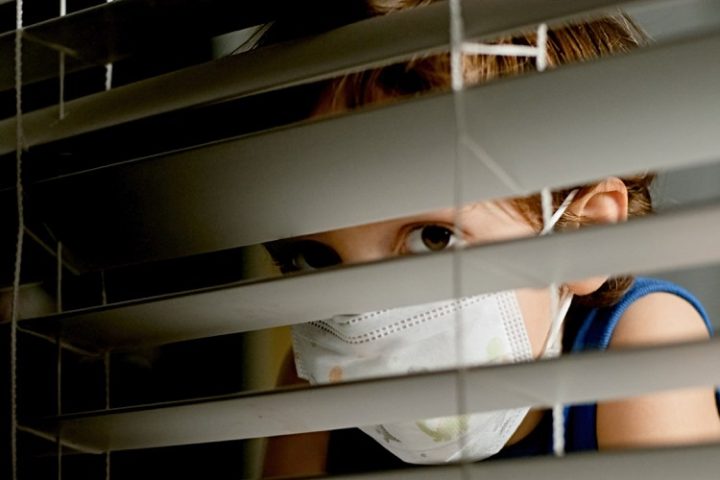
As tiny children walk around masked and isolated, all over a disease imperiling them less than the flu, some are asking a question:
What will be the consequences when little humans, social beings by nature, are raised in quarantine?
Suicides have already been attributed to the lockdowns. In April, 12-year-old Texas boy Hayden Hunstable took his own life, having been “badly affected by being separated from his friends and his routine,” reported the Mirror in May. “He didn’t like the isolation,” said Brad Hunstable, the lad’s father. “He didn’t like being at home” (video below).
Other apparent victims were 15-year-old Jo’Vianni Smith, a California girl; and British teen Corey Liversedge, whose suicides were also attributed, in part, to lockdowns.
Of course, though suicides are on the rise, most kids will survive quarantine. But there’s still a concern about their psychological well-being.
The New York Times’ Matt Richtel tackled this matter recently. Telling the story of two-year-old Alice McGraw, he wrote that she “was walking with her parents in Lake Tahoe this summer when another family appeared, heading in their direction. The little girl stopped.”
“‘Uh-oh,’ she said and pointed: “‘People.’”
Alice has, of course, been taught to be wary of people, to socially distance, and to commit to all of COVID ritual, which is so appealing, it seems, in a society that has lost its faith. Richtel states that she is a member of a generation being raised in a “bubble” — without other children.
“Gone for her and many peers are the play dates, music classes, birthday parties, the serendipity of the sandbox or the side-by-side flyby on adjacent swingsets,” writes Richtel. “Many families skipped day care enrollment in the fall, and others have withdrawn amid the new surge in coronavirus cases.” And with children poised to spend a long dark winter hidden away from other kids, many parents worry about how long-term social isolation will affect their youngsters.
“‘People are trying to weight [sic] pros and cons of what’s worse: putting your child at risk for COVID or at risk for severe social hindrance,’ said Suzanne Gendelman, whose daughter, Mila, 14 months old, regularly spent rug time with Alice McGraw before the pandemic,” relates Richtel.
The shame of this situation — and what journalists such as Richtel should be ashamed of — is that Gendelman finds the above a dilemma because of media malpractice. That is to say, the psychological effects of the given isolation may be debatable. Something else is not:
Young children are at essentially no risk from the China virus.
This is not opinion. The Centers for Disease Control (CDC) itself tells us the survival rate for people 0 to 19 years of age who contract SARS-CoV-2 is 99.997 percent. Moreover, a study out of Newcastle University in London found that the flu is at least twice as deadly to children under 10 as is COVID-19.
Note that this study is not an outlier, but has been affirmed by data from around the world. The proof is in the pudding, too: In California, which with 40 million people is our most populous state, two individuals under 18 have died of coronavirus. Overall, the disease has claimed 133 children nationwide during the course of more than one season (and this number is questionable, as some may be flu deaths), according to the American Academy of Pediatrics.
In contrast, 358 children died of the flu during the 2009-2010 season alone. So the conclusion is simple:
If you weren’t agonizing over whether to isolate your children during flu season, there’s no rational reason to worry about it now.
But there is reason to worry about the psychological, social, and perhaps neurological effects of COVID ritual. Richtel writes, for example, that “a growing number of studies highlight the value of social interaction to brain development. Research shows that neural networks influencing language development and broader cognitive ability get built through verbal and physical give-and-take — from the sharing of a ball to exchanges of sounds and simple phrases.”
“These interactions build ‘structure and connectivity in the brain,’ said Kathryn Hirsh-Pasek, director of the Infant Language Laboratory at Temple University and a senior fellow at the Brookings Institution,” Richtel continues. “‘They seem to be brain feed.’”
This said, “‘These children are not lacking in social interaction,’” Richtel quotes Brenda Volling, a psychology professor at the University of Michigan, as saying. Volling notes that “they are getting ‘the most important’ interaction from their parents,’” Richtel relates.
Obviously true, this is a point curiously ignored when mainstream media and academia evaluate homeschooling. (In fairness, Richtel applies the point only to extremely young children; the flip side, however, is that homeschooling families are generally larger than the apparently more secular families he featured, which means that the children will tend to have siblings available for interaction.)
The reality, though, is that the real concerns here weren’t addressed in Richtel’s piece. For example, human connection and association are important. Hillary Clinton herself co-opted the African saying that bespeaks of this, “It takes a village…,” using it as a metaphor for big government. But far from having a true village, and beginning perhaps with the Industrial Revolution, moderns’ transiency has diminished societal cohesion.
Our increasing mobility exacerbated this problem during the 20th century. Television, Internet, and other distractions also are factors, further “atomizing” society. After all, where there once might have been a tribe sitting around a fire and listening to oral history related by the resident raconteur, and where later families would eat dinner together, now people often are on different schedules and might dine alone in front of the TV or computer.
Portable electronic devices have exacerbated this all the more, with people often wedded to them when walking down the street and checking their phones incessantly during social affairs when, in earlier times, they’d be interacting more meaningfully with other humans. And now….
We have the Mask Empire. Robbers would wear masks to avoid identification, and now so many of us walk around looking like criminals, faceless beings with muffled voices, countenance hidden from neighbor. How much more does this eliminate human connection? And what effect will this have on children, being raised viewing every stranger as a threat to their very lives, being atomized and perhaps instilled with this new norm?
One larger civilizational effect is obvious. Whether it was the Romans scattering the Jews throughout their empire or the Marxists moving populations around in Eastern Europe to reduce the chances of resistance, divide and conquer is an old strategy. For an atomized people is easier to dominate.
Moreover, at the end of the day, what does it profit a civilization to gain the world but lose its soul? Should we further disrupt and shatter our culture in the name of combating a disease whose mortality rate approximates the flu’s?
For sure, the COVID panic-porn peddlers can’t say, “Do it for the children.” The disease just isn’t dangerous to them. But the supposed remedy sure may be.



